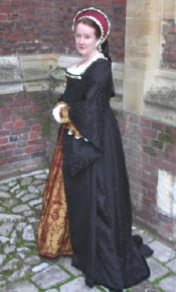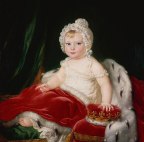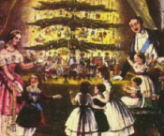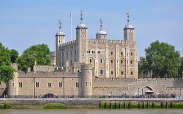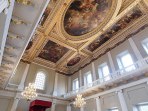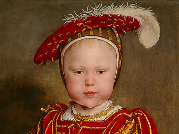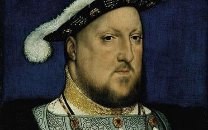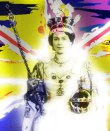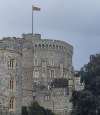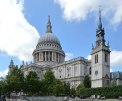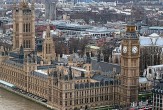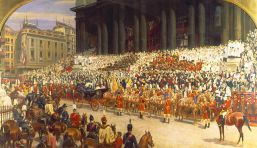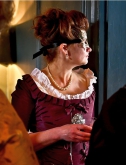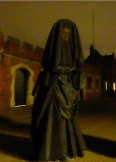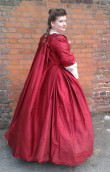
Lectures
Siobhan Elizabeth Clarke
Dress, Dazzle & Display
Tudor Dress was used as a political, economic and social tool and laws were passed to regulate dress throughout society. Elizabeth I, decked out in a dazzling array of jewels and clothes, projected the ultimate image of royal power.
Fashion was anything but frivolous!
Hampton Court Pleasure Palace
The story of two palaces: a Tudor palace made majestic by Henry VIII and a Baroque palace built by William & Mary. It's buildings, grounds and artefacts express maginificence. Yet, dig a little deeper and you will find other hidden stories, covering 500 years of history, as you walk the corridors of royal power and pleasure.
The Crown & the Cradle: Royal Babies
Royal babies have always excited interest because the direction of a dynasty was being defined and the health and survival of the child would shape history.
This lecture explores the stories of some of these royal babies: the circumstances of their arrival, their nursery years and historical significance, from the Wars of the Roses to the present day.
Royal Christmas
Our Christmas rituals evolved from Christian liturgy, pagan rites and the influence of the monarchy. The German customs of the
Victorian royal family became the basis of the English Christmas we know today.
This lecture explores Christmas at court from the middle ages to present day and how the royal family have influenced our own celebrations.
Majesty & Menace
The Tower of London has played a prominent role in English history since 1066, serving as a palace, an armoury, a treasury, a menagerie and the home of both the Royal Mint and Crown Jewels.
Under the Tudors, the Tower became known more as a high-profile prison and gained an enduring reputation as a place of torture and death.
The Jewel in the Lost Crown
The Banqueting House at Whitehall Palace was built for grand receptions & masques. This classical building was central to the Stuart dynasty and became famous as the scene of the execution of King Charles I.
The magnificent painted ceiling, by Peter Paul Rubens, is the only one in the world still in its original setting.
Windsor Castle – Fortress, Palace & Home
The oldest and largest continually occupied castle in the world. From its beginnings in 1080 to the present day, Windsor Castle has been linked throughout its history to the kings and queens of England. This talk will show you how it looks today, and how it has evolved through the centuries. As home to our current monarch, the old ceremonies & traditions continue to this day.
The Knights Templar – Saints or Sinners?
Created by one Pope, and destroyed by another, they were warrior monks, who went from power and riches to disgrace and oblivion. During the first crusade they protected pilgrims to the Holy Land. They were the most powerful men in Europe and bankers to kings, which led to their ultimate downfall. Shrouded in mystery, myths and legends, we will explore their rise and fall, and how their movement emerged again in the 1700's.
Royal Westminster – Monarchy, Government, Ceremony & Power
The seat of government and power for nearly one thousand years, this is where kings and queens have been born, crowned, married, died - and where history has been made. Follow the story, and hear why it continues to attract people today, from all over the world.
'Royal Jubilees - George III, Victoria, George V and Elizabeth II'.
A lecture about the origins of celebrating the Royal Jubilee, the pomp and pageantry but also the role that Hampton Court Palace played within the celebrations of the four monarchs.
Image: "Queen Victoria’s Diamond Jubilee Service, 22 June 1897"
by Andrew Carrick Gow. (Photo Wikimedia Commons, public domain).
'Secrets, Scandal and Salacious Gossip of the Royal Court, 1660 to 1830' is a very popular lecture. Sarah wears one of her beautiful costumes to present her PowerPoint presentation with images telling the tales of all the naughty bits of history you would probably not have learnt about at school! Sarah discusses the monarchs, their royal mistresses and methods of contraception of the time.
Warning, this talk is not for the prude, it is fun but rude!
This lecture can be delivered either in person or via Zoom or an electronic platform of your choice.
(Photo copyright by permission of Andrea Liu)
'Working with the Ghosts of Hampton Court Palace'
Sarah wears one of her costumes whilst she present her PowerPoint presentation with images detailing her experiences at Hampton Court. Sarah gives a glimpse of what it is like to wander the galleries late at night on her own in the dark, she will lead you on an exploration of the history, stories and sightings of some of the ghosts of Hampton Court Palace that have been reported over the last few hundred years.
Sarah can deliver this lecture either in person or via Zoom/an electronic platform of your choice.
(Photo copyright by permission of Ian Franklin)
'Kirtles, Corsets and Curtains'
Sarah talks about her journey into costuming and the levels of authenticity involved with making period costumes to wear as a tour guide. Sarah wears one of her costumes and will bring more along with a mannequin which she dress up. Sarah will present her PowerPoint presentation with images detailing how the 'perfect' silhouette has changed over time and how women have striven to attain it using foundation garments. This lecture can only be delivered in person.
(Photo copyright Sarah Slater)
